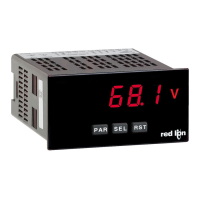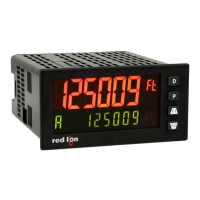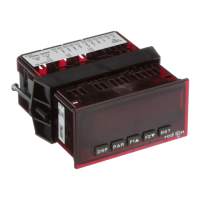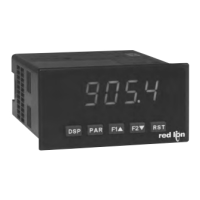-6-
Drawing No. LP0722 Released 2018-01-19
100.00
dSP 2
DISPLAY VALUE FOR SCALING POINT 2
-19999 to 99999
Enter the second Display Value by using the front panel buttons. This
is the same for KEY and APLY scaling styles. The decimal point follows
the dECPt selection.
General Notes on Scaling
1. When using the Apply (APLY) scaling style, input values for scaling
points must be confined to the range limits shown.
2. The same Input Value should not correspond to more than one Display
Value. (Example: 20 mA can not equal 0 and 20.)
3. For input levels beyond the programmed Input Values, the meter
extends the Display Value by calculating the slope from the two
coordinate pairs (INP1 / dSP1 & INP2 / dSP2).
KEy
StYLE
SCALING STYLE
If Input Values and corresponding Display Values are known, the Key-
in (KEY) scaling style can be used. This allows scaling without the
presence or changing of the input signal. If Input Values have to be
derived from the actual input signal source or simulator, the Apply (APLY)
scaling style must be used.
KEy APLY
0.00
INP 1
INPUT VALUE FOR SCALING POINT 1
For Key-in (KEY) style, enter the first Input Value using the front panel buttons.
(The Input Range selection sets the decimal location for the Input Value).
For Apply (APLY) style, the meter shows the previously stored Input
Value. To retain this value, press the SEL button to advance to the next
parameter. To change the Input Value, press the RST button and apply
the input signal to the meter. Adjust the signal source externally until the
desired Input Value appears. Press the SEL button to enter the value
being displayed.
0 to 29999
0.00
dSP 1
DISPLAY VALUE FOR SCALING POINT 1
-19999 to 99999
Enter the first Display Value by using the front panel buttons. This is
the same for KEY and APLY scaling styles. The decimal point follows the
dECPt selection.
100.00
INP 2
INPUT VALUE FOR SCALING POINT 2
0 to 29999
For Key-in (KEY) style, enter the known second Input Value using the
front panel buttons.
For Apply (APLY) style, the meter shows the previously stored Input
Value for Scaling Point 2. To retain this value, press the SEL button to
advance to the next parameter. To change the Input Value, press the
RST button and apply the input signal to the meter. Adjust the signal
source externally until the desired Input Value appears. Press the SEL
button to enter the value being displayed.
Display
Decimal
Point
Filter
Setting
Filter
Band
Input Value
for Scaling
Point 1
Display Value
For Scaling
Point 1
User Input
Assignment
Input
Range
PAR
User Input
Function
Input Value
for Scaling
Point 2
Display Value
For Scaling
Point 2
Scaling
Style
Display
Offset
Value
User Input
Active Level
rANGE
dECPt
FILtr
bANd
INP 1
dSP 1
INP 2
U-ASN
1-INP
Pro
dSP 2
USrIN
StYLE
OFSEt
U-Act
5.1 Module 1 - sIgnal Input paraMeters (1-INP)
PARAMETER MENU
200v
rAN6E
INPUT RANGE
Select the input range that corresponds to the external signal. This
selection should be high enough to avoid input signal overload but low
enough for the desired input resolution. This selection and the position of
the Input Range Jumper must match.
200uA
200.00 µA
10u
2u
0.2u
0.002A
10.000 V
2.0000 V
200.00 mV
2.0000 mA
20.000 mA
200.00 V
20.000 V
200.00 mA
0.02A
200u
20u
0.2A
SELECTION
RANGE
RESOLUTION
RANGE
RESOLUTION
SELECTION
0.00
dECPt
0.000 0.00000.000.00
DISPLAY DECIMAL POINT
Select the decimal point location for the Input, MIN and MAX displays.
This selection also affects the dSP1 and dSP2 parameters and setpoint
values and offset value..
0.00
OFSEt
DISPLAY OFFSET VALUE
The display can be corrected with an offset value. This can be used to
compensate for signal variations or sensor errors. This value is
automatically updated after a Zero Display to show how far the display is
offset. A value of zero will remove the effects of offset. The decimal point
follows the dECPt selection.
-19999 to 19999
1
FILtr
FILTER SETTING
If the displayed value is difficult to read due to small process variations
or noise, increased levels of filtering will help to stabilize the display.
Software filtering effectively combines a fraction of the current input
reading with a fraction of the previous displayed reading to generate the
new display.
Filter values represent no filtering (0), up to heavy filtering (3). A value
of 1 for the filter uses 1/4 of the new input and 3/4 of the previous display
to generate the new display. A filter value of 2 uses 1/8 new and 7/8
previous. A filter value of 3 uses 1/16 new and 15/16 previous.
0,1 2 3
10
bANd
FILTER BAND
The filter will adapt to variations in the input signal. When the variation
exceeds the input filter band value, the filter disengages. When the
variation becomes less than the band value, the filter engages again.
This allows for a stable readout, but permits the display to settle rapidly
after a large process change. The value of the band is in display units,
independent of the Display Decimal Point position. A band setting of ‘0’
keeps the filter permanently engaged at the filter level selected above.
0 to 199 display units

